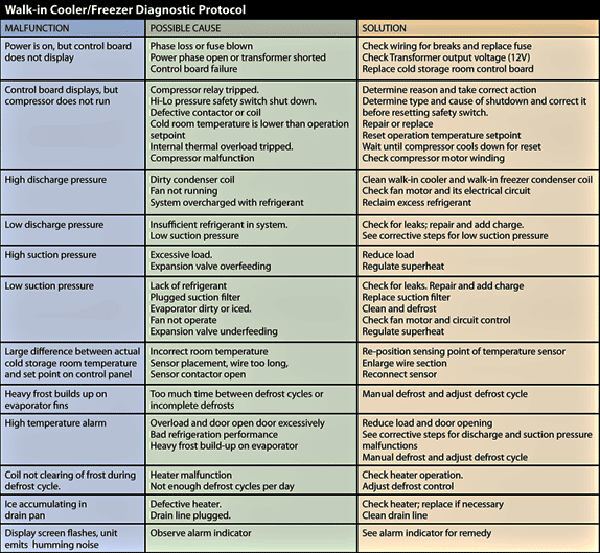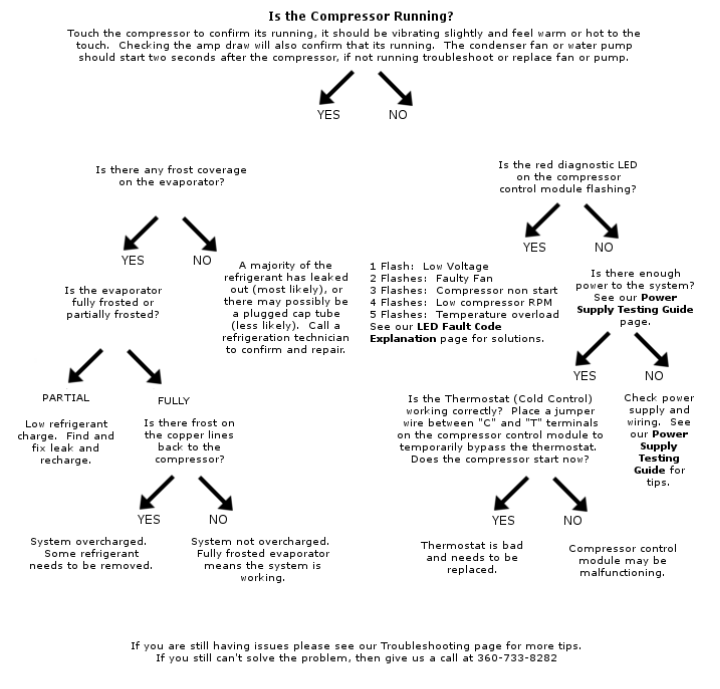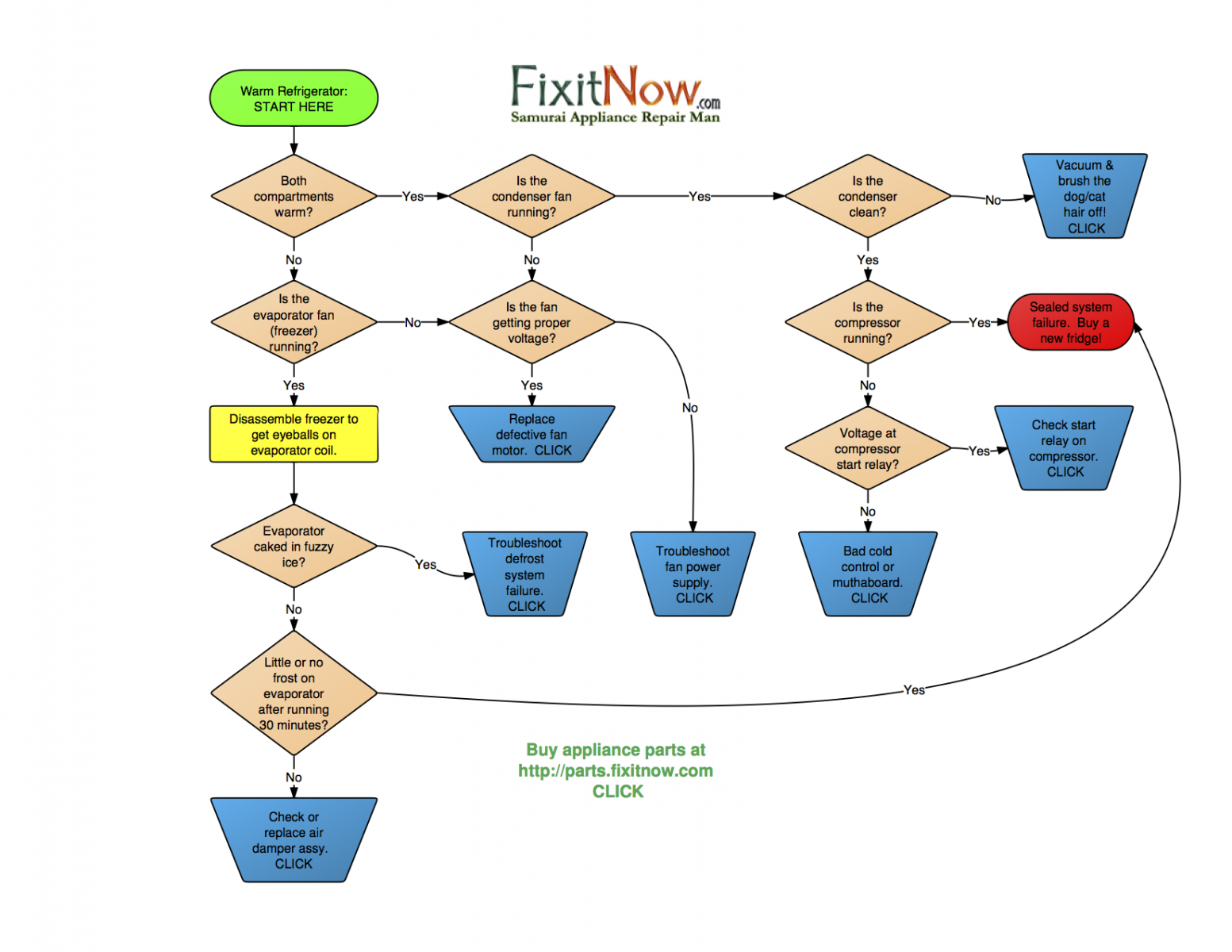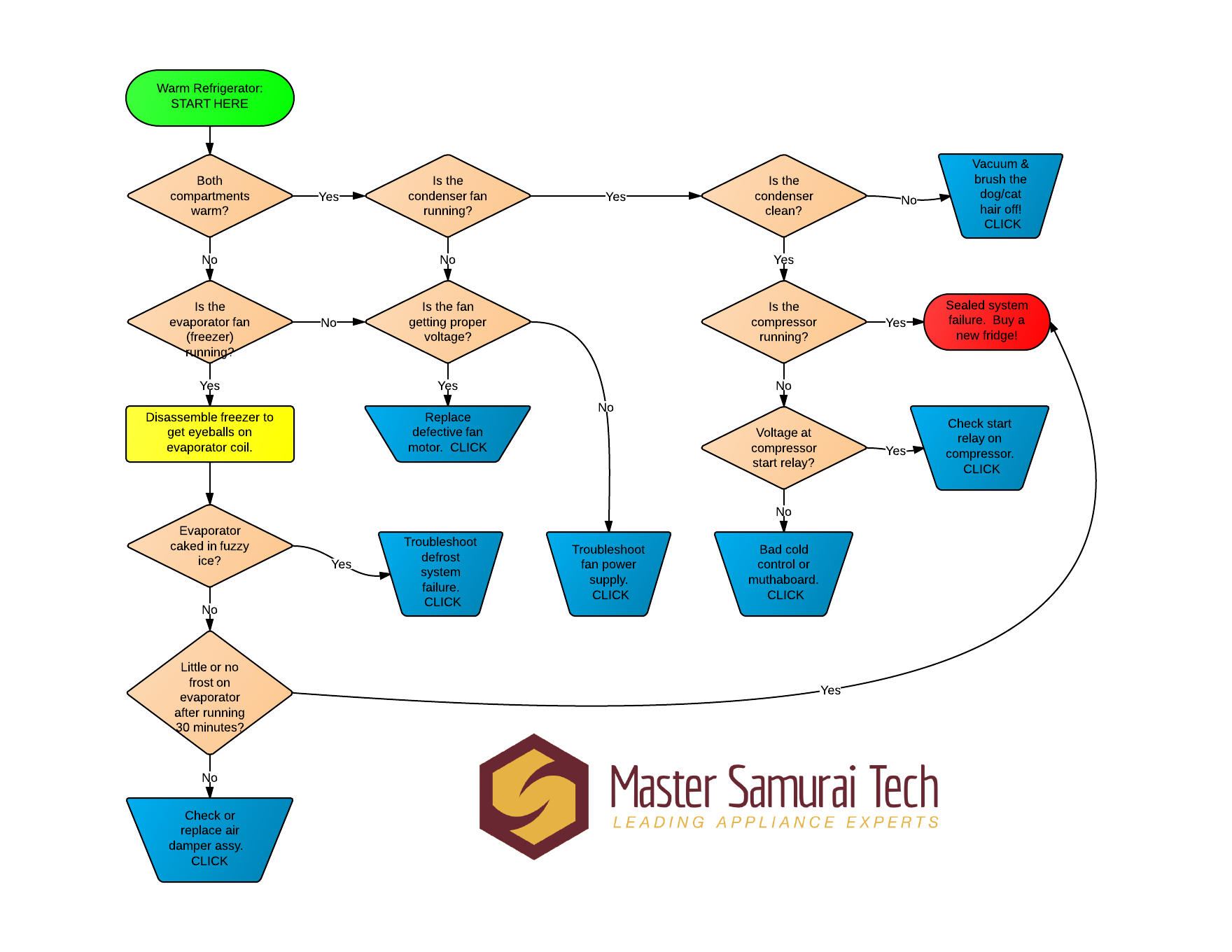
A refrigerator troubleshooting chart is a useful tool for diagnosing common issues with refrigerators. In this chart, you can find solutions to problems such as a refrigerator not cooling, water leaks, and unusual noises.
By referring to this chart, you can easily troubleshoot and resolve these issues, saving time and money on repairs. Keep reading to learn more about how a refrigerator troubleshooting chart can help you keep your appliance running smoothly.

Credit: www.seafreezeinc.com
Common Refrigerator Problems
When it comes to refrigerators, there are a few common problems that can occur. These issues can disrupt the proper functioning of your refrigerator and affect the freshness of your food. In this section, we will discuss some of the most common refrigerator problems and their possible solutions.
Refrigerator Is Not Cooling
If your refrigerator is not cooling properly, it can be frustrating and worrisome. There are a few reasons why this may be happening. One possible cause could be a malfunctioning thermostat. The thermostat regulates the temperature inside the refrigerator, and if it is not working correctly, the cooling process may be affected. Another common issue is a dirty condenser coil. Over time, dust and debris can accumulate on the condenser coil, hindering its ability to release heat and cool the refrigerator. It is important to clean the condenser coil regularly to prevent this from happening. Lastly, a faulty compressor can also lead to insufficient cooling. The compressor is responsible for compressing the refrigerant and transferring heat. If the compressor is not working properly, the refrigerator may not cool as it should.
Refrigerator Is Making Strange Noises
If your refrigerator is making strange noises, it can be quite unsettling. However, these noises can often be indicative of a minor problem. One common cause of strange noises is a build-up of ice on the evaporator fan. As the fan tries to push air through the ice, it can produce unusual sounds. Another possible reason for the noise could be a faulty condenser fan motor. The condenser fan motor helps circulate air and cool the compressor, but if it becomes worn out or damaged, it can create noise. Additionally, a noisy compressor may also be the culprit. If you notice loud humming or buzzing sounds coming from the compressor, it is advisable to get it checked by a professional.
Refrigerator Is Leaking Water
Finding water puddles around your refrigerator can be concerning. A leaking refrigerator can have a few potential causes. Firstly, it could be due to a clogged or frozen defrost drain. The defrost drain is responsible for carrying melted ice from the freezer to the drain pan. If it gets blocked, the water can overflow and leak onto the floor. Another possible reason for a water leak is a faulty water inlet valve. The water inlet valve controls the flow of water into the refrigerator for ice-making and water dispensing. If it becomes defective, it can cause water leakage. Lastly, a damaged or misaligned water line could also result in water pooling around the refrigerator.
By troubleshooting these common refrigerator problems and addressing them promptly, you can ensure the smooth functioning of your refrigerator and keep your food fresh for longer.

Credit: my.mastersamuraitech.com
Troubleshooting Steps
Discover the troubleshooting steps for your refrigerator with this handy refrigerator troubleshooting chart. Easily resolve common issues and keep your fridge running smoothly.
Check The Power Supply
Clean The Condenser Coils
Inspect The Door Seals
Adjust The Temperature Settings
Clear Any Blockages In The Drain Line
Check The Evaporator Fan
Replace Faulty Components
When your refrigerator is not functioning properly, it can be frustrating and lead to spoiled food. Instead of immediately reaching out to a technician, try troubleshooting the issue yourself. By following these easy steps, you might be able to identify and even resolve the problem. Below, we have outlined a helpful refrigerator troubleshooting chart that covers common issues and their solutions.Check The Power Supply
One of the first things you should check if your refrigerator is not working is the power supply. Make sure that the unit is properly plugged into the wall outlet and that the outlet itself is functioning by testing it with another appliance. Also, ensure that the circuit breaker for the refrigerator in your electrical panel hasn’t tripped. If all is well with the power supply, move on to the next step.Clean The Condenser Coils
Dirty condenser coils can cause your refrigerator to work inefficiently or not cool at all. Over time, dust and debris can accumulate on the coils, hindering their ability to dissipate heat. Cleaning the condenser coils should be done every six months to a year to maintain optimal performance. To clean the coils, disconnect the power supply and gently vacuum or brush off any dirt or debris. Be careful not to damage the coils as they are delicate.Inspect The Door Seals
Faulty door seals can lead to cold air escaping your refrigerator and warm air entering, causing it to work harder to maintain the desired temperature. Inspect the door seals visually for any cracks, tears, or gaps. Close the refrigerator door on a dollar bill and try to pull it out. If the bill slides out easily, it’s a sign that the door seal is not sealing properly. In this case, you may need to replace the door seal to ensure a tight seal.Adjust The Temperature Settings
If your refrigerator is not cooling properly, check the temperature settings. The ideal temperature for the refrigerator compartment is between 35°F and 38°F (1.7°C and 3.3°C) while the freezer should be set between 0°F and 5°F (-17.8°C and -15°C). Use a refrigerator thermometer to verify the temperature and adjust the settings accordingly. Allow 24 hours for the temperature to stabilize before rechecking.Clear Any Blockages In The Drain Line
A blocked drain line can cause water to accumulate inside the refrigerator or freezer compartments, leading to leaks and potential damage. If you notice water pooling at the bottom of your fridge or inside the freezer, there may be a blockage in the drain line. Clearing the blockage is usually as simple as using a small pipe cleaner or blowing air into the drain tube to remove the debris.Check The Evaporator Fan
The evaporator fan is responsible for circulating cool air throughout the refrigerator. If it stops working, you may notice that the fridge is not cooling evenly or not cooling at all. To check the evaporator fan, open the freezer compartment and listen for the sound of the fan running. If it’s not running, it may be faulty and require replacement. Consult your refrigerator’s user manual for guidance on how to access and replace the evaporator fan.Replace Faulty Components
If none of the above troubleshooting steps resolve the issue, it is likely that there are faulty components within your refrigerator. Depending on the specific problem, components such as the thermostat, defrost timer, or compressor may need to be replaced. In such cases, it is recommended to seek the assistance of a qualified technician who can accurately diagnose and repair the faulty parts. By following these troubleshooting steps, you can potentially identify and resolve common refrigerator issues. Remember to always prioritize safety and disconnect the power supply before attempting any repairs or maintenance tasks. Regularly performing these troubleshooting techniques can help keep your refrigerator running smoothly and efficiently for years to come.When To Call A Professional
When troubleshooting your refrigerator, it’s important to know when to call a professional. A reliable Refrigerator Troubleshooting Chart can help identify common problems and guide you on whether expert assistance is needed.
When to Call a Professional If you’re experiencing any issues with your refrigerator, it’s important to know when to call a professional for help. While some problems can be easily fixed on your own, others require the expertise of a trained technician. In this section, we’ll explore three common refrigerator problems that should prompt you to pick up the phone and contact a professional.Refrigerant Leak
One of the main reasons why your refrigerator may not be cooling properly is a refrigerant leak. Refrigerant is the substance that flows through the coils in your fridge, removing heat and keeping your food cold. If you notice that your refrigerator isn’t maintaining a cool temperature despite adjusting the thermostat, a refrigerant leak may be the culprit. A refrigerant leak is not a problem you want to handle yourself. It requires specialized tools and knowledge to locate and repair the leak. Additionally, refrigerants can be harmful to both your health and the environment, making it crucial to leave this task to a trained professional. When you suspect a refrigerant leak, contact a refrigerator repair expert immediately for prompt and safe resolution.Compressor Failure
The compressor is the heart of your refrigerator, responsible for pumping refrigerant throughout the cooling system. Any malfunction in the compressor can lead to a variety of issues, such as temperature fluctuations or complete loss of cooling. If you notice strange noises coming from your fridge, frequent cycling on and off, or if your unit is not cooling at all, it may be an indication of compressor failure. Repairing or replacing a faulty compressor requires technical expertise and specialized equipment. It’s not a task that can be easily tackled by a DIY enthusiast. Calling a professional is the best course of action to diagnose and resolve compressor-related problems. They will have the necessary skills to determine if a repair is possible or if a compressor replacement is needed.Electrical Problems
Another scenario that warrants professional intervention is if your refrigerator is experiencing electrical problems. Faulty wiring or a malfunctioning control board can cause your fridge to behave erratically, such as not turning on, tripping the breaker, or displaying error codes on the control panel. Handling electrical issues can be dangerous if you don’t have the required knowledge and experience. Therefore, it is always recommended to reach out to a professional technician who can safely troubleshoot and fix the electrical problems in your refrigerator. They will have the expertise to diagnose the root cause of the issue, whether it’s a faulty wire, a defective control board, or any other electrical component. In conclusion, when it comes to refrigerators, knowing when to call a professional is crucial. Refrigerant leaks, compressor failures, and electrical problems are complex issues that require the specialized skills and knowledge of a trained technician. By contacting a professional for help, you can ensure that your refrigerator is repaired safely and effectively, extending its lifespan and minimizing the risk of further damage.
Credit: my.mastersamuraitech.com
Frequently Asked Questions Of Refrigerator Troubleshooting Chart
How To Fix A Refrigerator That Is Not Cooling Properly?
If your refrigerator is not cooling properly, check if the condenser coils are dirty and clean them if necessary. Ensure that the temperature controls are set correctly and there is enough space for air circulation around the refrigerator. If the problem persists, it might be due to a faulty evaporator fan motor or a malfunctioning compressor, in which case professional help might be required.
Why Is My Refrigerator Making A Loud Noise?
A loud noise coming from your refrigerator could be due to various reasons. Check if the condenser fan motor is dirty or worn out and needs to be cleaned or replaced. Another possible cause is a faulty compressor, which might need to be repaired or replaced by a professional technician.
Additionally, inspect the evaporator fan motor or the condenser coils for any issues.
How To Fix A Leaking Refrigerator?
If your refrigerator is leaking, the first thing you should check is the water supply line and the drain pan. Ensure that the water supply line is properly connected and not leaking. If the drain pan is full, empty it and make sure it is positioned correctly.
Inspect the water inlet valve and the defrost drain to rule out any clogs or malfunctions. If the issue persists, it is advisable to seek professional help.
Conclusion
This refrigerator troubleshooting chart provides a valuable resource for diagnosing and fixing common issues with your appliance. By following the step-by-step instructions and handy tips provided, you can potentially save time and money by resolving minor problems on your own.
Remember, regular maintenance and proper care are essential for the longevity and optimal performance of your refrigerator. So, refer to this chart whenever you encounter a problem and troubleshoot with confidence. Keep your fridge running smoothly!






